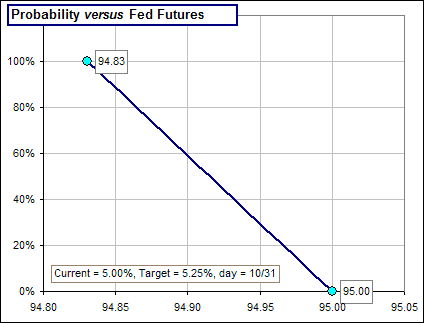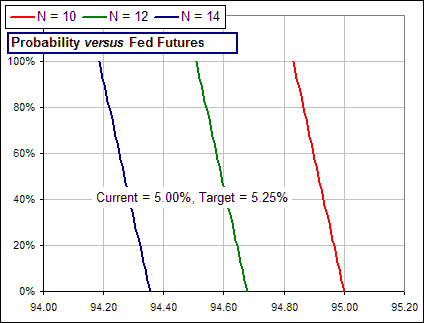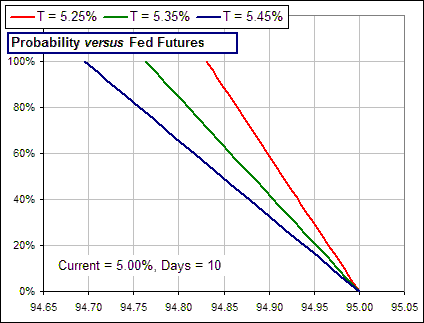| Predicting the Fed Rate |
Here's something I've never run across before ... predicting Fed Rate increases.
>There are plenty of things you haven't run across before, for example ...
Pay attention:
Suppose the Fed Rate on the 10th day of the month is 5.00%.
Suppose it changes to 5.25% for the remaining 21 days of the month.
What's the average Rate for the month?
>Uh ... I have no idea.
It'd be:
[1] (10/31)*5.00 + (21/31)*5.25 = 5.17.
See? (10/31) if the fraction of the 31-day month it was at 5.00 and (21/31) the fraction it was at 5.25.
>Yeah, sure ... you actually know the Fed Rate for the last 21 days? Good luck!
Okay, suppose we don't know the Fed Rate for the remainder of the month ... the last 21 days.
But, suppose that we figure there's a possibility of a Fed Rate increase from 5.00% to 5.25%.
Indeed, we assume a probability of p that the Rate will change to 5.25%
and a probability (1-p) it'll remain unchanged at 5.00%.
That gives an "Expected" Rate of
5.25p + (1-p)5.00
for the last 21 days of the month.
>Huh?
That's (probability of changing)*(the changed Rate) + (probability of no change)*(the current Rate)
... and that's what we should use for the Rate for the last 21 days.
>We should? Is that the best you can do ... calculate an "Expected" Rate?
Yes.
In place of [1], above, we can now write the average Rate for the 31-day month as:
[2] (10/31)*5.00
+ (21/31)*[5.25p + (1-p)5.00]
See? We've just replaced the unknown Rate for the last 21 days (in the magic formula [1]) by our Expected Rate: [5.25p + (1-p)5.00]
>And what's the probability of a change in Rate ... to 5.25%?
You mean p? Aah, that's the problem, eh?
We'd like to attach a probability to a Rate change to 5.25%. That is, we'd like to find the value of p.
Wouldn't it be great if we knew the average Rate for the month? Suppose it's 5.10. Then we'd have:
[3] (10/31)*5.00
+ (21/31)*[5.25p + (1-p)5.00]
= 5.10
and we could solve for: p = 0.59 or 59%.
We conclude that there's a 59% probability of a change in the Fed Rate ... namely an increase from the current 5.00% to 5.25%.
>Wonderful! Now how do we find out the average Rate for the month ... even though we're only at the 10th day of the month?
Okay, that's a fair question. We need to look into the future, perhaps like this.
Or, failing that, we ask the market what it thinks the future Rate will be ... by looking at the
Fed Futures.
If the Fed Futures are, say, 94.90, then "the markets" think the Fed rate will be 100 - 94.90 = 5.10%.
In general, we do it like so:
|
(N/D)(Current Fed Rate) + (M/D) [ p (New "Target" Fed Rate) + (1-p) (Current Fed Rate) ]
= FedFuturesRate = 100 - FedFutures
where D = N + M is the number of days in the month, it is currently day N and there are M days left in the month. We can solve for:
|
|
>And if the probability if negative or greater than 100%? What then?
>And how do we know that the Fed Futures correctly gauges the Fed Rate for the month?
|  |
 The probability changes as the day changes (that's N). |  The probability changes as the Target Rate changes (that's T). |
See: this or this or this (a PDF file with the magic formula).
